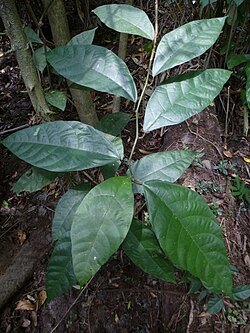Biology:Ficus asperifolia
| Ficus asperifolia | |
|---|---|

| |
| Scientific classification | |
| Kingdom: | Plantae |
| Clade: | Tracheophytes |
| Clade: | Angiosperms |
| Clade: | Eudicots |
| Clade: | Rosids |
| Order: | Rosales |
| Family: | Moraceae |
| Genus: | Ficus |
| Species: | F. asperifolia
|
| Binomial name | |
| Ficus asperifolia Miq.
| |
| Synonyms | |
|
List
| |
Ficus asperifolia is a species of shrub or small sized gynodioecious fig tree belonging to the family Moraceae.[1][2] It grows up to 6 m high and often has climbing branches.[3]
Description
Leaves of the species are elliptical to obovate in shape, up to 20 cm long and 8 cm wide, apex is long and acuminate while base is cuneate to obtusely rounded.[4] Leaves commonly have stipules; petiole is up to 1 cm long and margin tends to be lobed or dentate.[4] Peduncles, 2-15 mm long, the figs are orange to purplish red, up to 2 cm in diameter and globular in shape; figs are sometimes paired or single on leaf axils.[4][5]
Distribution and habitat
Ficus asperifolia occurs in Senegal westwards to Sudan and Kenya and southwards to Zambia.[1] It is found in savannahs and edges of gallery forests.[5]
Uses
In Cameroon dried fruit of the species are used in traditional medine to treate infertility,[1] extracts of the species are also used to aid the wound healing process.
References
- ↑ 1.0 1.1 1.2 Watcho, Pierre; Meli Watio, Hermine; Wankeu-Nya, Modeste; Ngadjui, Esther; Deeh Defo, Patrick; Nkeng-Efouet, Pepin Alango; Nguelefack, Telesphore Benoit; Kamanyi, Albert (2017). "Androgenic effects of aqueous and methanolic extracts of Ficus asperifolia in male Wistar rats" (in en). BMC Complementary and Alternative Medicine 17 (1): 42. doi:10.1186/s12906-016-1547-5. ISSN 1472-6882. PMID 28086774.
- ↑ Verkerke ,W. ,L987(a). Ovule dimorphism in ficus asperifolia Miquel . Acta Bot.Neer-I . 36: L2L-L24
- ↑ Beentje, H. J. (1988). "Fig trees (Ficus, Moraceae) of Kenya" (in en). Journal of the East Africa Natural History Society and National Museum 76 (198): 53–76. https://www.africabib.org/rec.php?RID=Q00007932.
- ↑ 4.0 4.1 4.2 Ndolo Ebika, S. T.; Morgan, D.; Sanz, C.; Harris, D. J. (2018-08-09). "Ficus Species in the Sangha Trinational, Central Africa". Edinburgh Journal of Botany 75 (3): 377–420. doi:10.1017/S0960428618000173. ISSN 1474-0036. https://journals.rbge.org.uk/ejb/article/view/1713.
- ↑ 5.0 5.1 Arbonnier, Michel; Arbonnier, Michel (2004). Trees, shrubs and lianas of West African dry zones. CIRAD. Weikersheim: Margraf Publ.. pp. 397–400. ISBN 978-3-8236-1419-7.
Wikidata ☰ Q15472355 entry
 |

